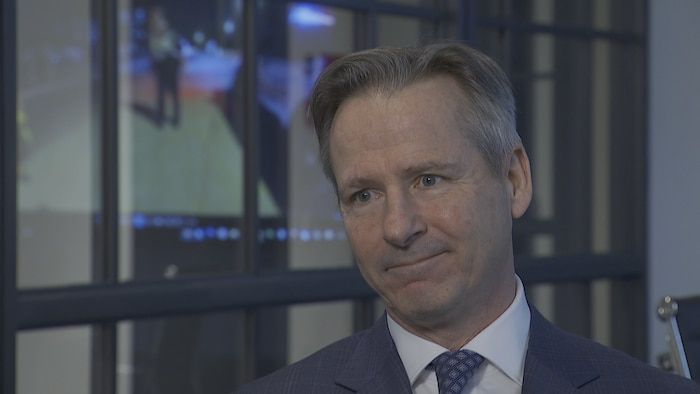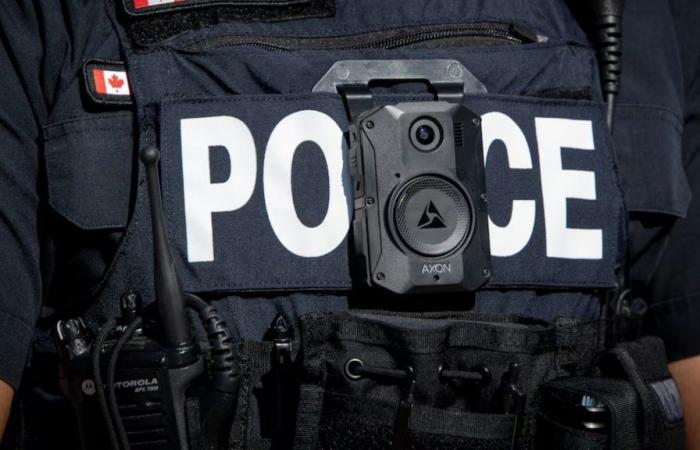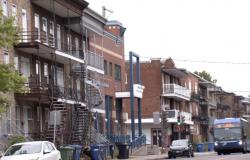Toronto police’s takedown of a homeless encampment near Lamport Stadium in 2021 was brutal. Clashes took place between police and protesters and 26 people were arrested and charged.
Several voices were raised to denounce the treatment that the police reserved for the demonstrators that day. Ollie D’Agostino is one of them.
A police officer allegedly hit him with a stick, which caused him physical and psychological injuries, Ollie D’Agostino testified by email. Even three years later, Ollie D’Agostino refuses to talk about his experience in person, as it is so painful for him.
Open in full screen mode
Several people were arrested during clashes between law enforcement and activists at Lamport Stadium in 2021. (File photo)
Photo: CBC / Evan Mitsui
His lawyer, David Shellnutt, made a freedom of information request to obtain recordings from the intervention cameras that the police officers were wearing that day so that they could be held accountable, but to no avail.
In a fairer world, the existence of these images would lead to real-world consequences and significant changes to policing as an institution. It’s just not the reality of what’s happening
says Ollie D’Agostino.
Toronto police say they are releasing the recordings in compliance with the Municipal Freedom of Information and Protection of Privacy Act.
Exceptions to the Municipal Access to Information Act
The law states that videos must be disclosed. However, there are several exceptions, for example:
-
To protect an ongoing investigation
-
To protect the identity of a person who has not given consent
-
To prevent revealing current investigative techniques
-
To protect a person’s life
The access to information request to obtain the videos was made by Me Shellnutt, who is defending five clients in connection with the dismantling of Lamport Stadium, including Ollie D’Agostino.
He also represented them in a civil lawsuit and claims that his clients were compensated in connection with the events of July 21, 2021.
Despite this compensation, he thinks it is important that the recordings be made public by the police. There was no public recognition. It is a civic service, financed by public funds and it must be publicly accountable
says David Shellnutt.
However, he abandoned his request for access to information after several unsuccessful email exchanges with the Toronto police.
Open in full screen mode
David Shellnutt believes the intervention cameras have not provided the level of transparency that was promised when the program launched in 2020 in Toronto.
Photo: Radio-Canada / Hugo Lévesque
This is not the first time he has encountered obstacles when trying to obtain images. David Shellnutt also made a request in another case where Hasani O’Gilvie, a University of Toronto student, was brutally arrested. The police were looking for another young black man.
When the video paints a negative portrait of the police, it appears to be buried.
Toronto police say they cannot release the video of Hasani O’Gilvie’s arrest because the matter is still before the Office of the Independent Police Review Director.
David Shellnutt appealed to the Office of the Information and Privacy Commissioner of Ontario. He is waiting for a decision.
Police reports
Toronto police recently began publishing an annual tally of public access to information requests for body camera videos.
% of requested body camera recordings have been disclosed, either in full or in part”,”text”:”If you look at 2023 data, 74% of requested body camera recordings have been disclosed, either in full or partly”}}”>If you look at 2023 data, 74% of requested camera recordings were leaked, either in full or in part
says Stephanie Sayer, a spokesperson for the Toronto police.
The 2023 report also shows, for example, that the protection of privacy is mentioned in 70% of cases as a reason for not disclosing information.
End of widget. Return to start of widget?
According to its own policies, Toronto police should also audit its program every year and make the results public.
This includes in particular a review of complaints and a sample of interventions where the use of force was used.
No reports have been released since the program launched in late 2020. However, police say they intend to release one shortly.
Ontario Newsletter
Subscribe to the Ontario newsletter.
Divergent experiences
Radio-Canada contacted around ten people who made access to information requests to obtain recordings from intervention cameras in Toronto.
The majority of them managed to get what they were looking for. However, their experiences vary greatly.
Our lawyers told us that this was a difficult, long and laborious procedure
writes the interim legal director of the organization Black Legal Action Center (BLAC), Danette Edwards.
She says her team has worked on complaints against the police, including following an altercation with officers, checking on a person’s well-being and a follow-up visit.
THE BLACK was able to obtain the desired recordings, but the organization sometimes had to wait up to six months for a copy of the recording.
Lawyer Patrick Brown, who defends victims and families who want compensation after serious injuries or the loss of a loved one, believes that the application process is effective.

Open in full screen mode
Patrick Brown says he and his team have obtained around twenty intervention camera videos from different police forces in the Greater Toronto Area in recent years.
Photo: Radio-Canada / Sue Goodspeed
We obtain [les enregistrements] on a regular basis and they have proven to be very very useful
he said.
Mr. Brown adds that victims can now win their case more easily since the videos help them prove the responsibility of the other party. It gives us access to the audio of what the people involved are saying [aux policiers].
The cameras are also valuable tools for members of the Special Investigations Unit (UES), which look at cases where a civilian is killed or injured in an interaction with the police.
Its spokesperson, Monica Hudon, explains that these recordings give an objective and precise version of events, even if they do not always tell the whole story.
This is an important step forward in the evolution of police accountability and civilian oversight of police.
Rémi Boivin, full professor at the School of Criminology at the University of Montreal, thinks that if the public has restricted access to videos from intervention cameras, it is above all a consequence of the laws which govern disclosure.
Police organizations should not be held responsible. Diffusion does not depend only on them
he explains.
He points out, for example, that videos are leaked much more quickly in the United States, where the laws are more permissive.








